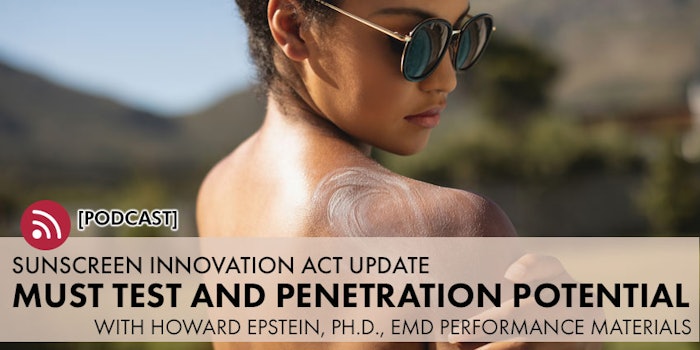
The FDA's latest sunscreen scrutiny is focused on the test protocol for the Maximal Usage Trial study (MUsT). This human pharmacokinetic test measures the amount of absorption of a drug into the body. What else might it tell us?
In a January 2020 meeting at the New York Chapter of Society of Cosmetic Chemists (NYSCC), Howard Epstein, Ph.D., director of technical services for EMD Performance Materials in Philadelphia, provided an update regarding the U.S. Food and Drug Administration’s (FDA’s) proposed changes to Sunscreen Innovation Act, introduced in February 2019.
Listen to the podcast:
Previous studies by the FDA evaluated the bloodstream of test subjects for the presence avobenzone, oxybenzone, octocrylene and ecamsule after the subjects applied sunscreens at their maximum suggested use rates. Findings showed sunscreens in the subjects’ bloodstreams at levels higher than permitted without the required additional nonclinical toxicology assessments, including for systemic carcinogenicity and additional developmental and reproductive studies. The agency noted the clinical implications of the presence of these sunscreens did not necessarily constitute a safety issue and required further investigation.
According to Epstein, similar research and results from the University of Maryland also found sunscreen penetration rates at levels that would require additional studies for carcinogenicity, and development and reproductive effects. Industry critiques of the FDA study, however, underlined that FDA researchers did not examine the effects of different product forms, vehicles and potential penetration aids in product formulas; it is unclear from the university study’s article abstract whether researchers factored these elements into their equation, or not. Per Epstein, additional FDA studies are now under way to elucidate the effects on penetration of these facets of sunscreen formulas.
“The FDA wants to test [the effects] of four vehicles, the penetration of organic sunscreens, and wants the industry to collaborate as a partner to run these studies—this is being discussed now,” Epstein said. “It also is determining which labs will do the studies for the industry and the four different vehicle types—since there are ingredients in skin care that can enhance penetration.”
Epstein continued, “What’s changed with respect to sunscreen evaluation is the current group that is evaluating sunscreens came from the drug/pharma side of the FDA, so the test model they are using now is designed for drugs; not necessarily OTC drugs but more prescription-like drugs. And [this] has never been applied previously for the sunscreens. … This is what has changed that has created this situation.”
He explained there is currently a model, the IVPT (In vitro permeation testing (IVPT)), that would be used initially. “[This is] the first test they will do to see if the different formulations will penetrate, then they will go to in vivo.” According to Epstein, the FDA also is discussing the time scale for all of this to be completed. “My sense … is that they (the FDA) will be open to some modifications but that will be in the spring.”
As an aside, he noted interest in going back to the researchers to get a sense from them about what actually may have enhanced the penetration of actives. “This could be an opportunity for formulators,” Epstein concluded.










